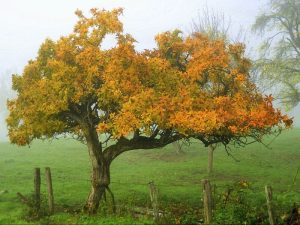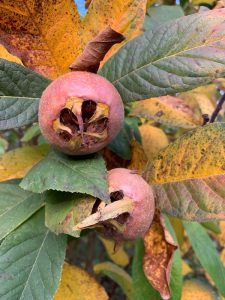The appealing medlar!
Robin Gale-Baker, from Sustainable Macleod, discusses growing medlars. This is one of a series of articles she has written about growing fruit trees (see right hand sidebar). She has also written a number of articles about growing various vegetables, growing various herbs and general growing techniques.
Read an article about medlars by Anna Matilda (aka Urban Nanna), from Forest Hill. Also, read recipes for medlar cheese, medlar tart and medlar jelly.
 In my garden, a fruit tree needs to serve several purposes and our combined total of 40 fruit trees need together to meet a range of criteria. These include giving us fruit year round, beautiful flowers and autumn colour. The medlar is one of our favourite trees because it gives us winter fruit, late summer cream flowers tinged with pink, and autumnal leaves that range from gold to orange to deep red and last through to the end of June.
In my garden, a fruit tree needs to serve several purposes and our combined total of 40 fruit trees need together to meet a range of criteria. These include giving us fruit year round, beautiful flowers and autumn colour. The medlar is one of our favourite trees because it gives us winter fruit, late summer cream flowers tinged with pink, and autumnal leaves that range from gold to orange to deep red and last through to the end of June.
The medlar is a lesser known fruit tree and not often grown (although there are some spectacular trees in old gardens). It bears fruit that most people do not recognise. They are about the size and shape of a rounded crab apple with a calyxed bottom. Unripened, the fruit is green and moves through orangey colours to a deep russet to brown. In contrast to what many books say, I don’t find this unappealing. The fruit tastes like a tangy apple sauce and has the texture of  thickened sauce that is deep brown in colour. To the uninitiated eye it may look like the ripe flesh has rotted but it is this over-ripeness that gives medlar its distinct taste. The process is called ‘bletting’, where ‘bletting’ means that the fruit has fermented beyond ripeness. This is a very different process to rotting. Other fruits that blet include persimmon and quince.
thickened sauce that is deep brown in colour. To the uninitiated eye it may look like the ripe flesh has rotted but it is this over-ripeness that gives medlar its distinct taste. The process is called ‘bletting’, where ‘bletting’ means that the fruit has fermented beyond ripeness. This is a very different process to rotting. Other fruits that blet include persimmon and quince.
Bletting can be achieved in two ways. Either remove the fruit and store on straw or paper towel or newspaper in a single layer, calyx down and stem upward, in a warm and airy place (darkness not necessary) for 2-3 weeks until soft or leave on the tree and pick them when soft. Sometimes the fruit will drop before being ready for harvesting and then should be stored as in the first method. You can also dip the stalks in a strong salt and water mix to prevent any mould setting in.
The best way to prepare a medlar for eating is to strip it out of the skin by squeezing it from the calyx end and keep stripping it until all the pulp is out, especially that close to the skin. I strip it into a strainer as it has quite large, hard stones and I use the back of a dessert spoon to press it through. I serve it with cheeses, just as you would use quince paste. It can also be added to cream, apparently goes with any wine, and is best known in either medlar jelly or medlar cheese (which is like a curd). Sally Wise’s book entitled A year in a bottle contains recipes for both medlar jelly and medlar liqueur.
The medlar tree itself has its origins in the Balkans, Iran and Turkmenistan despite its botanical name being Mespilus germanica. There is a large type called Dutch, with fruit 5-6cm in diameter, and a smaller type, the Common Medlar, of which the Nottingham variety is best known, with fruit 2-2.5cm. I grow the Common Medlar and, at present (mid June), mine still has around 150 fruit on it. Plant medlars in winter and train them early to a vase shape like an apple tree.
Medlars are unfussy about soil type, other than disliking chalk soils, but require good drainage. They do not need fertilising and they need very little pruning other than to keep the centre open for good ventilation and dead branches removed. They are rarely attacked by pests or disease. They like a sunny position but will grow in partial shade and it is best to provide some shelter from wind as the branches are brittle and flowers can blow off in strong wind.
